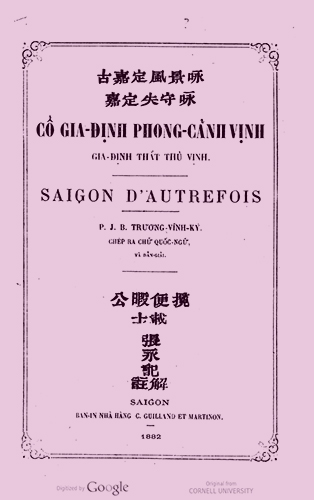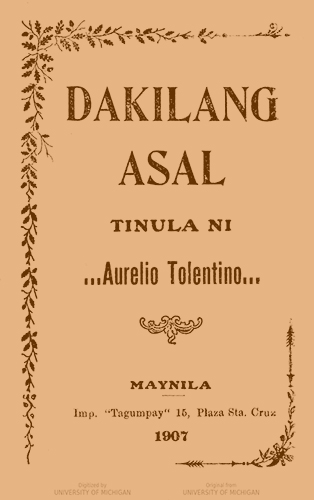Tag: BL Southeast Asia
Thai
The Languages of Berkeley: An Online Exhibition

From the beginning of its known history, Thai was the official language of the monarchy of Thailand. Spoken by more than 60 million people today, it retains a formal vocabulary of respect, used in ritual and in addressing the royal family. Its writing system is a careful adaptation of that of Khmer to a language with a distinct sound pattern and flavor.[1]
Prachum kāp hē r̄ưa is a collection of Kāp hē r̄ưa. Kāp hē r̄ưa is a traditional genre of Thai literature written and used for royal barge processions in Thailand. The content of Kāp hē r̄ưa is usually a description of a variety of royal barges and natural scenery that the poet sees along the way, especially trees, fish, and birds. Some poets also write about their lovers from whom they have to part upon their journey.
The Department of South & Southeast Asian Studies (SSEAS) at UC Berkeley offers programs in both undergraduate and graduate instruction and research in the languages and civilizations of South and Southeast Asia from the most ancient period to the present. Instruction includes intensive training in several of the major languages of the area including Bengali, Burmese, Hindi, Khmer, Indonesian (Malay), Pali, Prakrit, Punjabi, Sanskrit (including Buddhist Sanskrit), Filipino (Tagalog), Tamil, Telugu, Thai, Tibetan, Urdu, and Vietnamese, and specialized training in the areas of literature, philosophy and religion, and general cross-disciplinary studies of the civilizations of South and Southeast Asia.[2] Outside of SSEAS where beginning through advanced level courses are offered in Thai, related courses are taught and dissertations produced across campus in Anthropology, Asian American Studies, Comparative Literature, Ethnic Studies, Folklore, History, Linguistics and Political Science (re)examining the rich history and culture of Thailand.[3]
Arthit Jiamrattanyoo
PhD Student, Department of History, University of Washington
Sources consulted:
- Dalby, Andrew. Dictionary of Languages: The Definitive Reference to More Than 400 Languages. New York: Columbia University Press, 1998.
- Department of South & Southeast Asian Studies, UC Berkeley (accessed 2/21/20)
- Thai (THAI) – Berkeley Academic Guide (accessed 2/21/20)
~~~~~~~~~~
Title: Prachum kāp hē r̄ưa
Title in English: n/a
Author: Gedney, William J., Damrongrāchānuphāp Prince, son of Mongkut, King of Siam 1862-1943.
Imprint: [Phranakhō̜n?]: Rōngphom Sōphon Phiphatthanākō̜n, 2460 [1917].
Edition: 1st edition
Language: Thai
Language Family: Kra-Dai
Source: HathiTrust Digital Library (University of Michigan)
URL: https://catalog.hathitrust.org/Record/000415896
The Languages of Berkeley is a dynamic online sequential exhibition celebrating the diversity of languages that have advanced research, teaching and learning at the University of California, Berkeley. It is made possible with support from the UC Berkeley Library and is co-sponsored by the Berkeley Language Center (BLC).
Follow The Languages of Berkeley!
Subscribe by email
Contact/Feedback
ucblib.link/languages
Malay/Indonesian
The Languages of Berkeley: An Online Exhibition

Senandung jiwaku is a selection of poems by Mulyono Saleh published in various Indonesian newspapers and magazines between 1963 and 1976 that he entitled “The Song of My Soul.” The poems show the author’s concerns, love, and hope for his country (Indonesia) and his fellow countrymen, as well as religious reflections. He pays particular attention to marginalized segments of society such as women (mothers and national heroines) and ordinary people like grassroots farmers and fishermen.
Ethnologue lists 719 distinct languages, mostly indigenous, spoken in Indonesia, making it the most linguistically diverse country on the planet.[1] For at least a thousand years, however, Malay has held the position of lingua franca of the maritime region of the great Malay archipelago, which is now divided between Indonesia and Malaysia. The names bahasa Indonesia (“Indonesian language) and bahasa Malaysia (“Malaysian language”) — both standardized varieties of Malay — were introduced in the 20th century to differentiate the two national languages.[2] Indonesia is now the fourth most populous nation in the world. Of its large population, the majority speak Indonesian, making it one of the most widely spoken languages in the world.[3]
The Department of South & Southeast Asian Studies (SSEAS) at UC Berkeley offers both undergraduate and graduate instruction and research in the languages and civilizations of South and Southeast Asia from the most ancient period to the present. Instruction includes intensive training in several of the major languages of the area including Bengali, Burmese, Hindi, Khmer, Indonesian (Malay), Pali, Prakrit, Punjabi, Sanskrit (including Buddhist Sanskrit), Filipino (Tagalog), Tamil, Telugu, Thai, Tibetan, Urdu, and Vietnamese, and specialized training in the areas of literature, philosophy and religion, and general cross-disciplinary studies of the civilizations of South and Southeast Asia.[4] Outside of SSEAS where beginning through advanced level courses are offered in Indonesian, related courses are taught and dissertations produced across campus in Anthropology, Comparative Literature, Ethnic Studies, History, Linguistics, Music, and Political Science (re)examining the rich history and cultures of Indonesia.[5]
Yusmarni Djalius, PhD Student
Lecturer, Department of South & Southeast Asian Studies
Sources consulted:
- Ethnologue: Languages of the World (accessed 11/8/19)
- Dalby, Andrew. Dictionary of Languages: The Definitive Reference to More Than 400 Languages. New York: Columbia University Press, 1998.
- Sneddon, James Neil. The Indonesian Language: Its History and Role in Modern Society. Sydney: UNSW Press, 2003.
- Department of South & Southeast Asian Studies, UC Berkeley (accessed 11/8/19)
- Indonesian (INDONES) – Berkeley Academic Guide (accessed 11/8/19)
~~~~~~~~~~
Title: Senandung jiwaku: kumpulan sajak Mulyono Saleh
Title in English: The Song of My Soul
Author: Saleh, Mulyono
Imprint: Bandung : Tarate, 1976.
Edition: 1st edition
Language: Malay/Indonesian
Language Family: Austronesian, Malayo-Polynesian
Source: Center for Research Libraries
URL: https://dds.crl.edu/crldelivery/28736
The Languages of Berkeley is a dynamic online sequential exhibition celebrating the diversity of languages that have advanced research, teaching and learning at the University of California, Berkeley. It is made possible with support from the UC Berkeley Library and is co-sponsored by the Berkeley Language Center (BLC).
Follow The Languages of Berkeley!
Subscribe by email
Contact/Feedback
ucblib.link/languages
Vietnamese
The Languages of Berkeley: An Online Exhibition
In the 17th century, French Catholic missionaries employed the Roman alphabet to devise a unique orthography for the Vietnamese language. This was the first time in world history that an alphabet represented distinctions in tone.[1] This specially developed Latin script or quốc ngữ, with its double diacritics, coexisted with hán nôm — the Vietnamese adaptation of Chinese script — for three centuries before triumphing under Colonial rule.[2] Scholar Trương Vĩnh Ký (Pétrus Ky) rewrote and annotated this rare work of poetry in romanized Vietnamese toward the end of the 19th century featured here in its original version of the “rhyme-prose” in hán nôm script. It describes many interesting landscapes and social life customs in Gia Dinh (Hồ Chí Minh City) today.
The Department of South & Southeast Asian Studies (SSEAS) at UC Berkeley offers both undergraduate and graduate instruction and research in the languages and civilizations of South and Southeast Asia from the most ancient period to the present. Instruction includes intensive training in several of the major languages of the area including Bengali, Burmese, Hindi, Khmer, Indonesian (Malay), Pali, Prakrit, Punjabi, Sanskrit (including Buddhist Sanskrit), Filipino (Tagalog), Tamil, Telugu, Thai, Tibetan, Urdu, and Vietnamese, and specialized training in the areas of literature, philosophy and religion, and general cross-disciplinary studies of the civilizations of South and Southeast Asia.[3] Outside of SSEAS beginning through advanced level courses are offered in Vietnamese, related courses are taught and dissertations produced across campus in Asian American Studies, Comparative Literature, Ethnic Studies, Folklore, French, History, Linguistics, and Political Science (re)examining the rich history and culture of Vietnam.[4] UC Berkeley’s Center for Southeast Asia Studies is also the editorial home of the Journal of Vietnamese Studies, published by the University of California Press.[5]
Contribution by Hanh Tran
Lecturer, Department of South & Southeast Asian Studies
Virginia Shih
Curator for the Southeast Asia Collection, South/Southeast Asia Library
Sources consulted:
- Garry, Jane, and Carl R. G. Rubino. Facts About the World’s Languages: An Encyclopedia of the World’s Major Languages, Past and Present. New York: H.W. Wilson, 2001.
- Dalby, Andrew. Dictionary of Languages: The Definitive Reference to More Than 400 Languages. New York: Columbia University Press, 1998.
- Department of South & Southeast Asian Studies, UC Berkeley (accessed 10/1/19)
- Vietnamese (VIETNMS) – Berkeley Academic Guide (accessed 10/1/19)
- Journal of Vietnamese Studies. Berkeley, CA. University of California Press, 2006-.
~~~~~~~~~~
Title: C̉ô Gia-định phong-cảnh vịnh. Gia-định th́ât thủ vịnh. Saigon d’autrefois.
Title in English: [Saigon Bay Scene. Saigon of Old]
Author: Trương, P. J. B. Vĩnh Ký (Pétrus Jean-Baptiste Vĩnh Ký), 1837-1898.
Imprint: Saigon, C. Guilland et Martinon, 1882.
Edition: 1st edition
Language: Vietnamese
Language Family: Austroasiatic, Mon-Khmer
Source: HathiTrust Digital Library (Cornell University)
URL: https://catalog.hathitrust.org/Record/100620763
The Languages of Berkeley is a dynamic online sequential exhibition celebrating the diversity of languages that have advanced research, teaching and learning at the University of California, Berkeley. It is made possible with support from the UC Berkeley Library and is co-sponsored by the Berkeley Language Center (BLC).
Follow The Languages of Berkeley!
Subscribe by email
Contact/Feedback
ucblib.link/languages
Filipino (Tagalog)
The Languages of Berkeley: An Online Exhibition
“Tagalog, or Filipino, is said to mean ‘river people’ from taga- ‘place of origin’ and ilog “river,'” writes the linguist and historian Andrew Dalby. Already a language of written culture in the region of Manila on the island of Luzon when the Spanish invaded in the late 16th century, Filipino spread across the Philippine archipelago over thousands of years and was declared the first official language in the 1940s when independence from the United States was in sight.”[1]
During the Spanish colonial period, publishing in Filipino and other indigenous languages was largely religious in inspiration while incorporating distinctive Tagalog poetic forms. One of Aurelio Tolentino’s most famous works of verse, Dakilang Asal (“Noble Behavior”) is a series of ten didactic poems conveying a code of upright moral conduct meant to instruct the lives of Filipino youth. Presented as the basis for a buhay ng lahat ng dunong (life of all wisdom), Tolentino emphasizes key ethical virtues that remain prominent in Filipino culture, i.e. parental reverence, utang na loob (debt of gratitude), cleanliness, modesty, and humility.
The Department of South & Southeast Asian Studies (SSEAS) at UC Berkeley offers both undergraduate and graduate instruction and research in the languages and civilizations of South and Southeast Asia from the most ancient period to the present. Instruction includes intensive training in several of the major languages of the area including Bengali, Burmese, Hindi, Khmer, Indonesian (Malay), Pali, Prakrit, Punjabi, Sanskrit (including Buddhist Sanskrit), Filipino (Tagalog), Tamil, Telugu, Thai, Tibetan, Urdu, and Vietnamese, and specialized training in the areas of literature, philosophy and religion, and general cross-disciplinary studies of the civilizations of South and Southeast Asia.[2] Outside of SSEAS where beginning through advanced level courses are offered in Filipino, related courses are taught and dissertations produced across campus in Asian American Studies, Comparative Literature, Ethnic Studies, Folklore, History, Linguistics, and Political Science (re)examining the rich history and culture of the Philippines.[3]
Contribution by Gabrielle Pascua,
Undergraduate, Department of History
Sources consulted:
- Dalby, Andrew. Dictionary of Languages: The Definitive Reference to More Than 400 Languages. New York: Columbia University Press, 1998.
- Department of South & Southeast Asian Studies, UC Berkeley (accessed 6/18/19)
- Filipino (FILIPN) – Berkeley Academic Guide (accessed 6/18/19)
~~~~~~~~~~
Title: Dakilang Asal
Title in English: Noble Behavior
Author: Tolentino, Aurelio, 1867-1915.
Imprint: Maynila : Imp. Tagumpay, 1907.
Edition: 1st edition
Language: Filipino (Tagalog)
Language Family: Austronesian, Malayo-Polynesian
Source: HathiTrust Digital Library (University of Michigan)
URL: https://catalog.hathitrust.org/Record/003560966
Other online editions:
- Project Gutenberg, http://www.gutenberg.org/ebooks/13687
The Languages of Berkeley is a dynamic online sequential exhibition celebrating the diversity of languages that have advanced research, teaching and learning at the University of California, Berkeley. It is made possible with support from the UC Berkeley Library and is co-sponsored by the Berkeley Language Center (BLC).
Follow The Languages of Berkeley!
Subscribe by email
Contact/Feedback
ucblib.link/languages
![The Languages of Berkeley [fan]](https://update.lib.berkeley.edu/wp-content/uploads/2019/02/fan_languages-450px.jpg)

